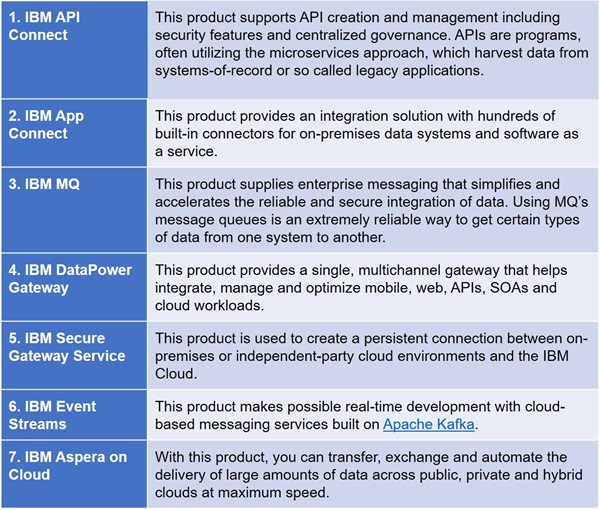Three Innovative Middleware Solutions
A discussion of WebSphere Application Server, IBM Cloud Integration and IBM Automation Platform for Digital Business middleware offerings.
This week, I am finishing up this three-part series on middleware. In the first post in the series, I discussed the roots of middleware in what I referenced as the real history of middleware, with the real roots being in centralized enterprise systems. Last week, I discussed the taxonomy and market size of middleware. This week, I’ll finish with a discussion of three innovative middleware products.
I selected different middleware solutions that either provided an opportunity to do something big or provide a solution to a major challenge. Chances are you’re not familiar with all three of the solutions I selected, so hopefully you will learn something about where middleware solutions are evolving in the marketplace.
IBM WebSphere Application Server
IBM WebSphere Application Server (WAS) is a well-established middleware product that fits the classic description of middleware–it occupies the space between the application and the kernel of the platform upon which the application runs. WAS is a software framework that runs on z/OS, IBM i, Linux, AIX, HP-UX, Solaris and the Windows OSes. One simple way to start to understand the product is to think of it as an environment that enables a programming model with the following dimensions:
- Supports Java specifications and other open standards (like HTML, XML and Web Services) for developing applications
- Provides WebSphere programming model extensions (like the internationalization service) to enhance application functionality
- Includes containers and services in the application server (like a security programming model and infrastructure), used by deployed applications, and which sometimes can be extended
The product provides the support that applications need to thrive in a diverse, open and heterogeneous computing environment. Here are five ideas that help you to further explore WAS.
- Application Servers: The product supports applications servers that are Java VMs running applications.
- Web Servers: Applications work with the HTTP plug in for the web server used with the application like IBM HTTP Server.
- Messaging: The product supports the Java Message Service specifications so WebSphere MQ and other organizations’ products can be used for messaging functionality.
- Shared Libraries: Libraries can be used by multiple applications and can be defined at the node or server level.
- System Administration: The product provides an administrative console to guide you through deployment and systems administration tasks.
Please visit the WebSphere Application Server: Overview web page as it contains a diagram that shows a single application server installation. It exposes the parts that pertain to the programming model (like the Java EE connector architecture services) and also reveals aspects of the product architecture (like the Admin application with scripting client and console). The diagram will help answer questions that you might have after reading this introductory part of the blog post on WAS.
IBM Cloud Integration
One of the most challenging situations in IT today is making cloud and on-premise applications work together. This is called the hybrid integration challenge. The scope of the challenge is compounded by the use of different cloud and in-house platforms, the drive to support digital transformation involving mobile technologies and various self-service methods that have been developed by suppliers. These are some of the factors that have converged, and this complexity exists as layers within the integration problem domain.
There isn’t one simple way to fix this problem. To address this challenge, IBM has created a set of integration capabilities that work together as a system. These capabilities, imbedded in a variety of products and tools, are used to support API programs that integrate the application functions in the different systems and to provide gateway functions to handle access to different workloads and to handle security between platforms. These are just two examples of the needed integration functionality.
The table below contains a list of seven products that are components of IBM Cloud Integration. You may not need all the products to solve your specific integration challenges.

To try out these products, you can sign up for an IBMid and create your IBM Cloud account. With this ability to test drive, you can build on IBM Cloud for free with no time restrictions and IBM guarantees free development with Lite plans.
IBM Automation Platform for Digital Business
As an area of specialization, IT automation has been growing steadily since the mid-1990s. Initially, automation efforts were home grown using in-house developed software. Eventually, products entered the market that really firmed up the job of automating at a commercial scale. The IBM Automation Platform for Digital Business is an integrated platform of five automation capabilities. These capabilities help business people drive many types of automation projects quickly and effectively. With the product, you can automate repetitive human tasks, content management, process workflows, data capture and business decisions with the platform’s flexible, integrated capabilities. Five main areas of focus include:
- Tasks where you use bots to automate human undertakings
- Content where you share and manage enterprise items like documents and other materials
- Workflow where you design and manage end-to-end business processes
- Capture where you classify and extract data from content
- Decisions where you automate processing choices with business rules
Flexible deployment options are available from IBM including running the software on your cloud, the IBM Cloud or on premises if you aren’t yet running your own private cloud and public cloud isn’t an option. The flexibility of these options removes the barriers to get started and see how organizations can benefit from these services.
What’s Next?
In January, I’ll begin with a brief retrospective on the series and posts that meant the most in 2018. Before moving forward, it’s great to look back on a few topics that really had special interest.